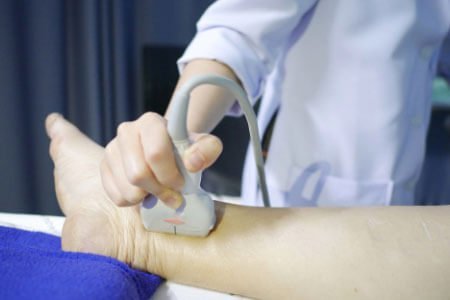Deep Vein Thrombosis (DVT)
Causes, Symptoms, Complications, Prevention, Diagnosis and Treatment
What would you like to know?
How is Deep Vein Thrombosis prevented?
To prevent this condition from developing, individuals can practice simple techniques such as:
- Avoid sitting still
- Lose weight in the case of obese people
- Quit smoking
- Regular exercises
How is Deep Vein Thrombosis diagnosed?
Even in case of mild symptoms, it is important to seek the help of medical professionals. The diagnosis usually begins when the doctor first observes the affected area, and recommends the right diagnostic procedures to ensure diagnosis followed by the correct treatment strategy.
Some of these common diagnostic assessments are:
- Ultrasound
- Blood test
- Venography
- CT scan
- MRI
We provide a wide range of diagnostic procedures at Yashoda Hospitals, Hyderabad for different kinds of orthopedic diseases. We have highly-trained personnel and experienced doctors who help us in carrying out these activities smoothly and within no time making us one of the top centers in India.

What is the treatment for Deep Vein Thrombosis?
Some of the common treatment facilities employed for patients suffering from deep vein thrombosis are:
- Using blood thinners: Deep vein thrombosis treatment most commonly used anticoagulants (blood thinners) that reduce blood clots. They don’t break or dissolve existing clots, but prevent the clots from increasing in size and reduce the chances of developing more clots.
- Clot busters: Thrombolytics or clot busters are drugs to break up blood clots. They are given through an IV line or a catheter placed in the clot directly. They are used in severe cases only.
- Filters: When a patient cannot take medicines to prevent the blood from clotting, then the doctors might fit a filter into the vena cava. This filter prevents the broken clots from entering the lungs.
- Compression stockings: These stockings are worn to encourage blood flow to the affected area and it helps prevent swelling associated with deep vein thrombosis.
- Surgery: Open thrombectomy is the surgery that is performed to remove deep vein clot when the condition doesn’t respond to any medication or non-surgical treatments. Open thrombectomy is occasionally recommended to remove a deep vein clot.
Our team of experts has treated a variety of patients with DVT disorders over the years with the help of our experienced doctors, surgeons, and staff making us one of the top hospitals near you.
You may also interested in reading
Read More Information
References:
- Deep Vein Thrombosis. Healthline. Available at: https://www.healthline.com/health/deep-venous-thrombosis Accessed on June 10, 2020.
- Deep Vein Thrombosis. Mayo Clinic. Available at: https://www.mayoclinic.org/diseases-conditions/deep-vein-thrombosis/symptoms-causes/syc-20352557 Accessed on June 9, 2020.
- Deep Vein Thrombosis. WebMD. Available at: https://www.webmd.com/dvt/default.htm Accessed on June 10, 2020.
- Deep Vein Thrombosis. NHS. Available at: https://www.nhs.uk/conditions/deep-vein-thrombosis-dvt/ Accessed on June 10, 2020.
- Deep Vein Thrombosis. Medical News Today. Available at: https://www.medicalnewstoday.com/articles/153704 Accessed on June 10, 2020.
Disclaimer:
“The content of this publication has been developed by a third party content providerwho are clinicians and/or medical writers and/or experts. The information contained herein is for educational purpose only and we request you to please consult a Registered Medical Practitioner or Doctor before deciding the appropriate diagnosis and treatment plan.”



 Appointment
Appointment Second Opinion
Second Opinion WhatsApp
WhatsApp Call
Call More
More





